HI6028 Taxation Law: Assignment on Tax Theory, Holmes Institute
VerifiedAdded on 2022/11/13
|9
|2218
|478
Homework Assignment
AI Summary
This assignment provides solutions to several taxation law questions related to capital gains tax (CGT) implications on the sale of collectibles like paintings, sculptures, and jewelry, as well as the determination of income from personal exertion versus capital gains in scenarios involving book authorship and copyright assignment. It also addresses the taxability of loan repayments with additional gains, referencing relevant sections of the Income Tax Assessment Act and case law to support the analysis and conclusions. The document analyzes various financial transactions under Australian tax law, determining whether they are subject to CGT or considered income from personal exertion.
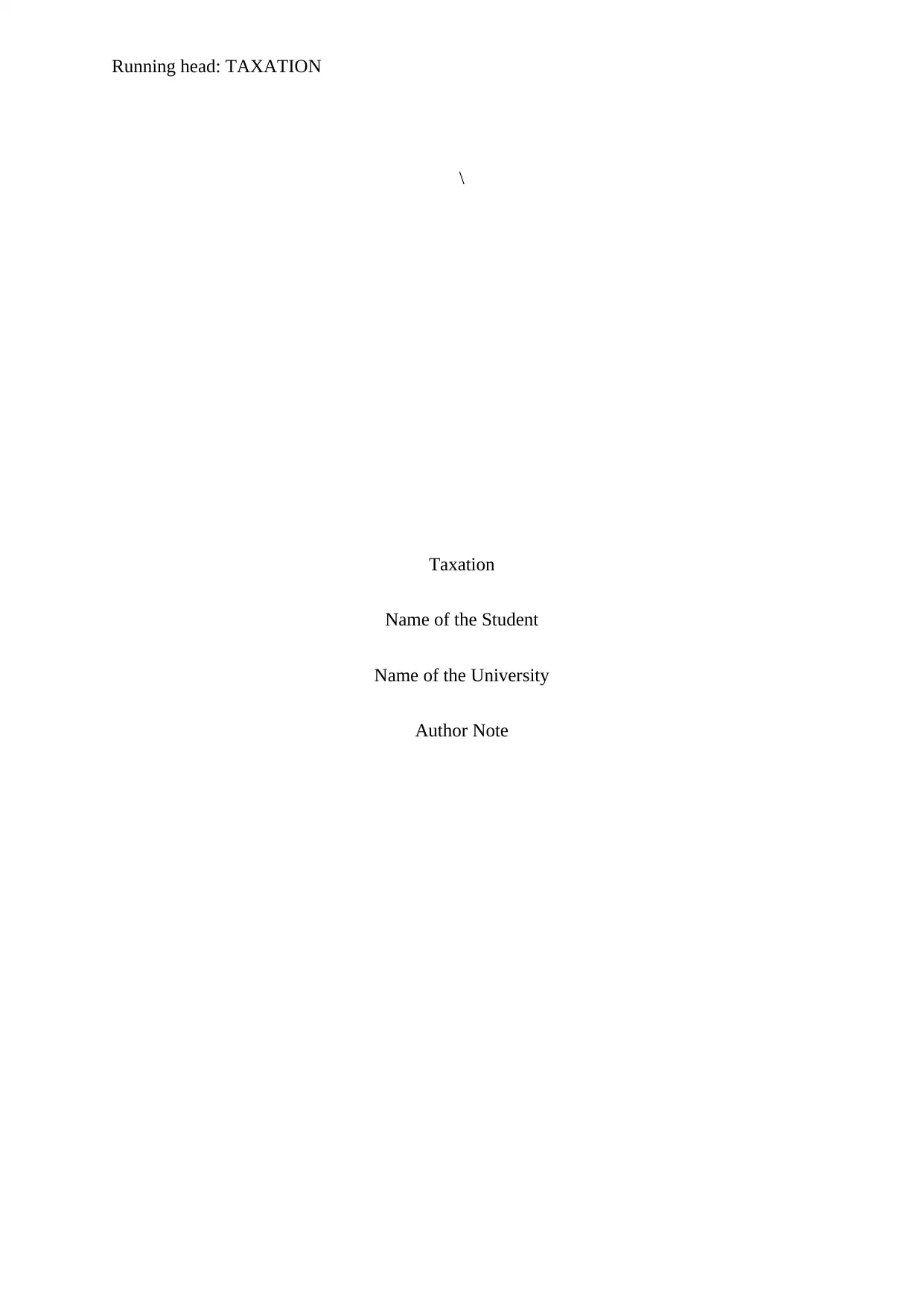
Running head: TAXATION
\
Taxation
Name of the Student
Name of the University
Author Note
\
Taxation
Name of the Student
Name of the University
Author Note
Paraphrase This Document
Need a fresh take? Get an instant paraphrase of this document with our AI Paraphraser
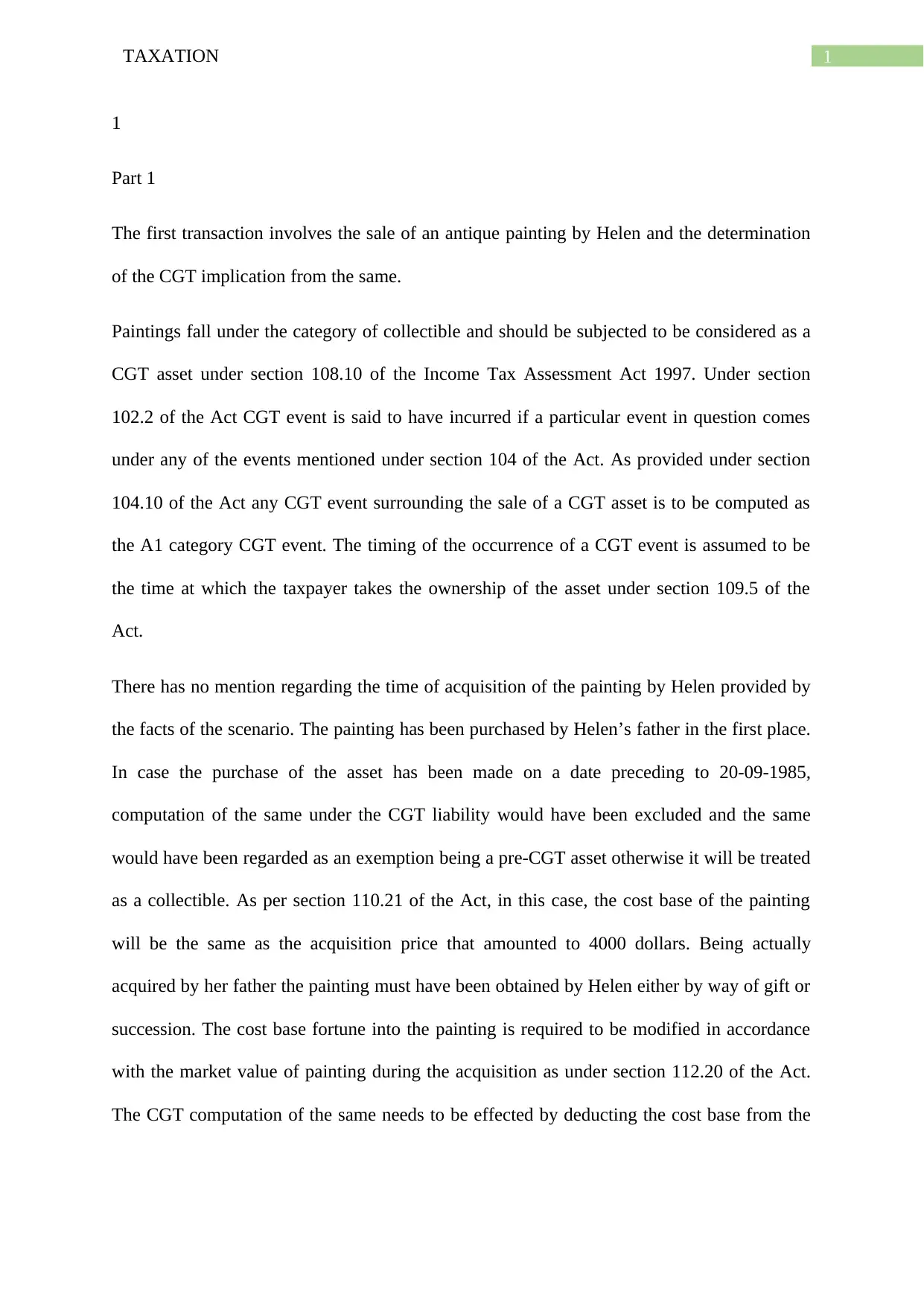
1TAXATION
1
Part 1
The first transaction involves the sale of an antique painting by Helen and the determination
of the CGT implication from the same.
Paintings fall under the category of collectible and should be subjected to be considered as a
CGT asset under section 108.10 of the Income Tax Assessment Act 1997. Under section
102.2 of the Act CGT event is said to have incurred if a particular event in question comes
under any of the events mentioned under section 104 of the Act. As provided under section
104.10 of the Act any CGT event surrounding the sale of a CGT asset is to be computed as
the A1 category CGT event. The timing of the occurrence of a CGT event is assumed to be
the time at which the taxpayer takes the ownership of the asset under section 109.5 of the
Act.
There has no mention regarding the time of acquisition of the painting by Helen provided by
the facts of the scenario. The painting has been purchased by Helen’s father in the first place.
In case the purchase of the asset has been made on a date preceding to 20-09-1985,
computation of the same under the CGT liability would have been excluded and the same
would have been regarded as an exemption being a pre-CGT asset otherwise it will be treated
as a collectible. As per section 110.21 of the Act, in this case, the cost base of the painting
will be the same as the acquisition price that amounted to 4000 dollars. Being actually
acquired by her father the painting must have been obtained by Helen either by way of gift or
succession. The cost base fortune into the painting is required to be modified in accordance
with the market value of painting during the acquisition as under section 112.20 of the Act.
The CGT computation of the same needs to be effected by deducting the cost base from the
1
Part 1
The first transaction involves the sale of an antique painting by Helen and the determination
of the CGT implication from the same.
Paintings fall under the category of collectible and should be subjected to be considered as a
CGT asset under section 108.10 of the Income Tax Assessment Act 1997. Under section
102.2 of the Act CGT event is said to have incurred if a particular event in question comes
under any of the events mentioned under section 104 of the Act. As provided under section
104.10 of the Act any CGT event surrounding the sale of a CGT asset is to be computed as
the A1 category CGT event. The timing of the occurrence of a CGT event is assumed to be
the time at which the taxpayer takes the ownership of the asset under section 109.5 of the
Act.
There has no mention regarding the time of acquisition of the painting by Helen provided by
the facts of the scenario. The painting has been purchased by Helen’s father in the first place.
In case the purchase of the asset has been made on a date preceding to 20-09-1985,
computation of the same under the CGT liability would have been excluded and the same
would have been regarded as an exemption being a pre-CGT asset otherwise it will be treated
as a collectible. As per section 110.21 of the Act, in this case, the cost base of the painting
will be the same as the acquisition price that amounted to 4000 dollars. Being actually
acquired by her father the painting must have been obtained by Helen either by way of gift or
succession. The cost base fortune into the painting is required to be modified in accordance
with the market value of painting during the acquisition as under section 112.20 of the Act.
The CGT computation of the same needs to be effected by deducting the cost base from the
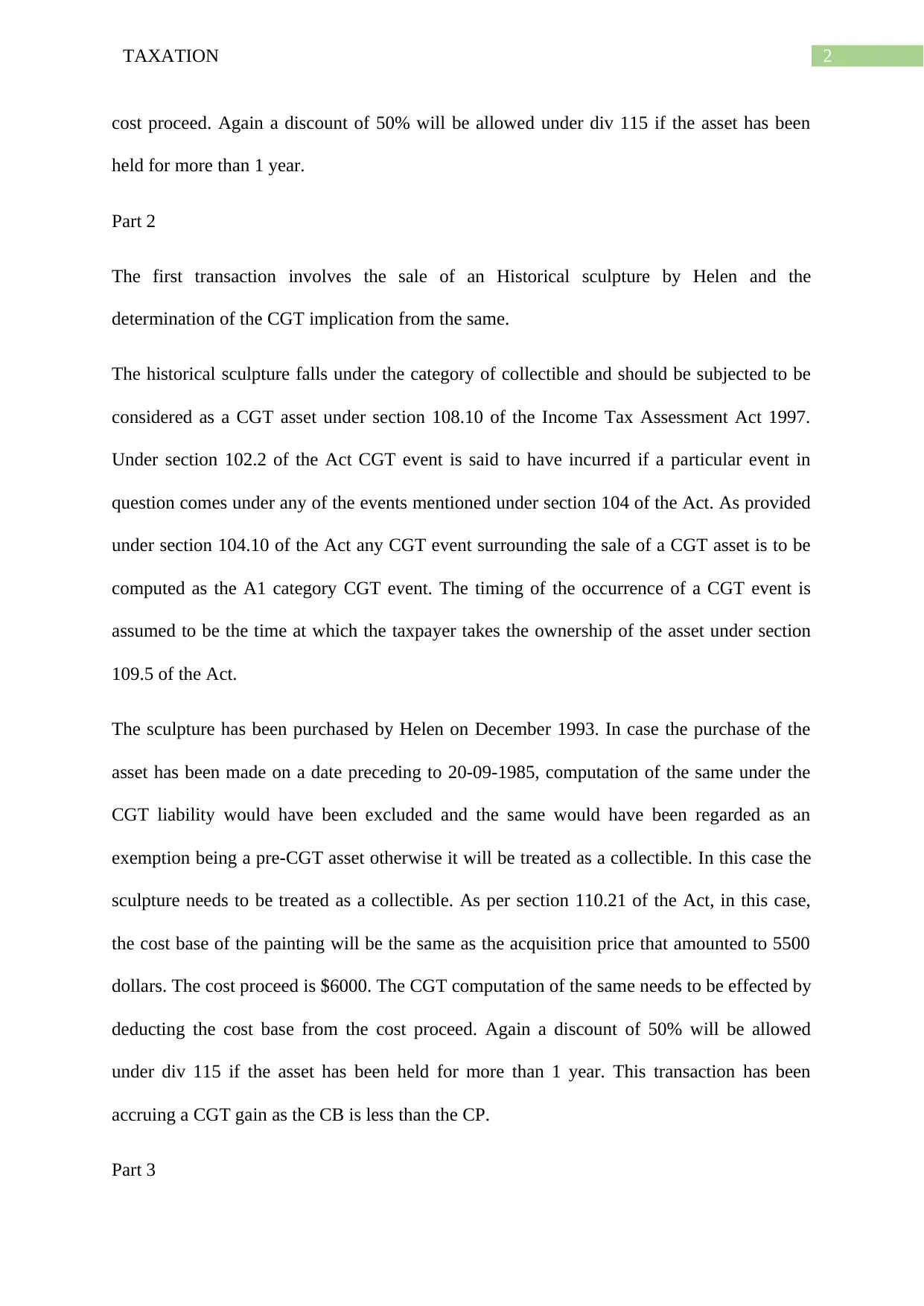
2TAXATION
cost proceed. Again a discount of 50% will be allowed under div 115 if the asset has been
held for more than 1 year.
Part 2
The first transaction involves the sale of an Historical sculpture by Helen and the
determination of the CGT implication from the same.
The historical sculpture falls under the category of collectible and should be subjected to be
considered as a CGT asset under section 108.10 of the Income Tax Assessment Act 1997.
Under section 102.2 of the Act CGT event is said to have incurred if a particular event in
question comes under any of the events mentioned under section 104 of the Act. As provided
under section 104.10 of the Act any CGT event surrounding the sale of a CGT asset is to be
computed as the A1 category CGT event. The timing of the occurrence of a CGT event is
assumed to be the time at which the taxpayer takes the ownership of the asset under section
109.5 of the Act.
The sculpture has been purchased by Helen on December 1993. In case the purchase of the
asset has been made on a date preceding to 20-09-1985, computation of the same under the
CGT liability would have been excluded and the same would have been regarded as an
exemption being a pre-CGT asset otherwise it will be treated as a collectible. In this case the
sculpture needs to be treated as a collectible. As per section 110.21 of the Act, in this case,
the cost base of the painting will be the same as the acquisition price that amounted to 5500
dollars. The cost proceed is $6000. The CGT computation of the same needs to be effected by
deducting the cost base from the cost proceed. Again a discount of 50% will be allowed
under div 115 if the asset has been held for more than 1 year. This transaction has been
accruing a CGT gain as the CB is less than the CP.
Part 3
cost proceed. Again a discount of 50% will be allowed under div 115 if the asset has been
held for more than 1 year.
Part 2
The first transaction involves the sale of an Historical sculpture by Helen and the
determination of the CGT implication from the same.
The historical sculpture falls under the category of collectible and should be subjected to be
considered as a CGT asset under section 108.10 of the Income Tax Assessment Act 1997.
Under section 102.2 of the Act CGT event is said to have incurred if a particular event in
question comes under any of the events mentioned under section 104 of the Act. As provided
under section 104.10 of the Act any CGT event surrounding the sale of a CGT asset is to be
computed as the A1 category CGT event. The timing of the occurrence of a CGT event is
assumed to be the time at which the taxpayer takes the ownership of the asset under section
109.5 of the Act.
The sculpture has been purchased by Helen on December 1993. In case the purchase of the
asset has been made on a date preceding to 20-09-1985, computation of the same under the
CGT liability would have been excluded and the same would have been regarded as an
exemption being a pre-CGT asset otherwise it will be treated as a collectible. In this case the
sculpture needs to be treated as a collectible. As per section 110.21 of the Act, in this case,
the cost base of the painting will be the same as the acquisition price that amounted to 5500
dollars. The cost proceed is $6000. The CGT computation of the same needs to be effected by
deducting the cost base from the cost proceed. Again a discount of 50% will be allowed
under div 115 if the asset has been held for more than 1 year. This transaction has been
accruing a CGT gain as the CB is less than the CP.
Part 3
⊘ This is a preview!⊘
Do you want full access?
Subscribe today to unlock all pages.

Trusted by 1+ million students worldwide
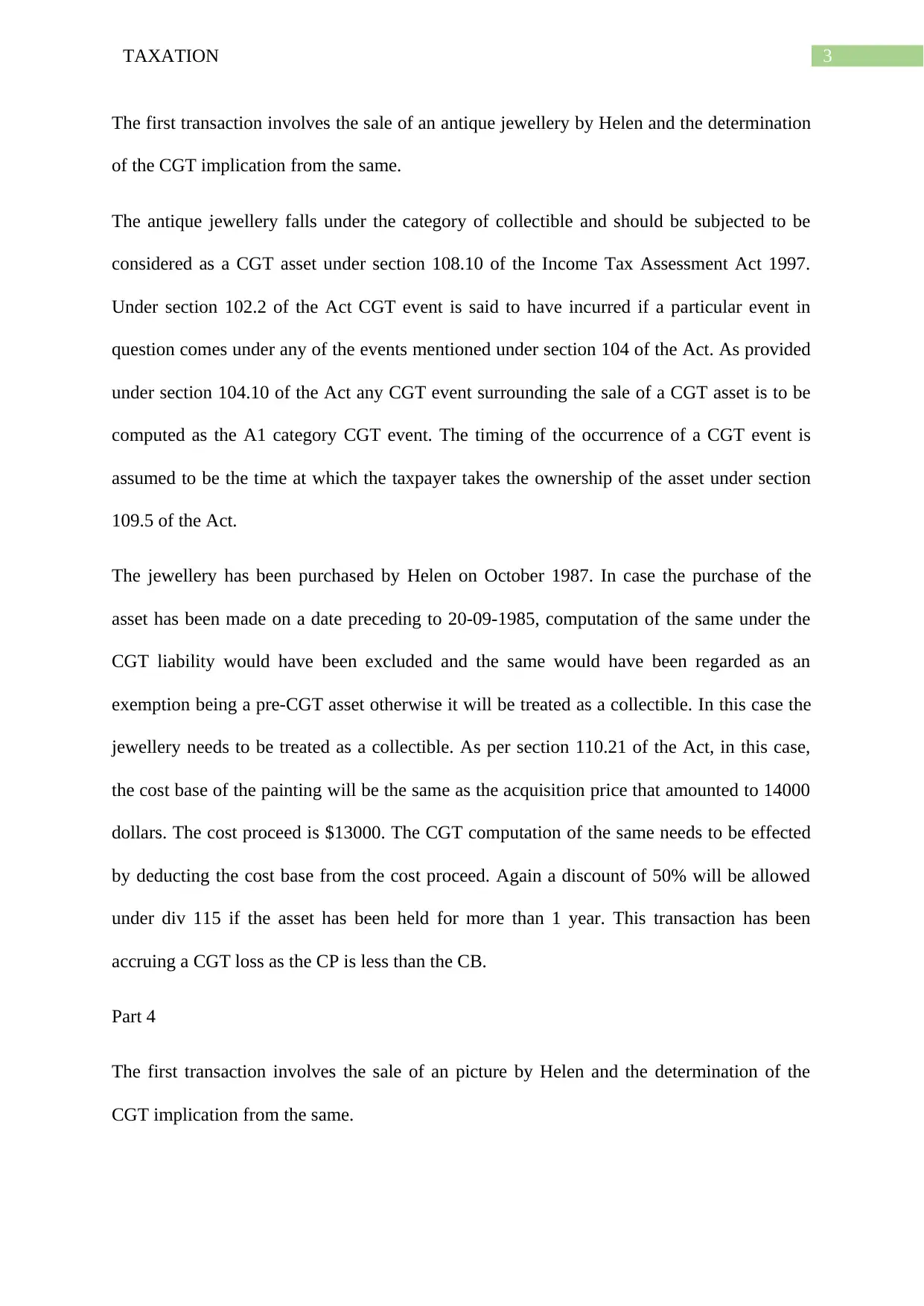
3TAXATION
The first transaction involves the sale of an antique jewellery by Helen and the determination
of the CGT implication from the same.
The antique jewellery falls under the category of collectible and should be subjected to be
considered as a CGT asset under section 108.10 of the Income Tax Assessment Act 1997.
Under section 102.2 of the Act CGT event is said to have incurred if a particular event in
question comes under any of the events mentioned under section 104 of the Act. As provided
under section 104.10 of the Act any CGT event surrounding the sale of a CGT asset is to be
computed as the A1 category CGT event. The timing of the occurrence of a CGT event is
assumed to be the time at which the taxpayer takes the ownership of the asset under section
109.5 of the Act.
The jewellery has been purchased by Helen on October 1987. In case the purchase of the
asset has been made on a date preceding to 20-09-1985, computation of the same under the
CGT liability would have been excluded and the same would have been regarded as an
exemption being a pre-CGT asset otherwise it will be treated as a collectible. In this case the
jewellery needs to be treated as a collectible. As per section 110.21 of the Act, in this case,
the cost base of the painting will be the same as the acquisition price that amounted to 14000
dollars. The cost proceed is $13000. The CGT computation of the same needs to be effected
by deducting the cost base from the cost proceed. Again a discount of 50% will be allowed
under div 115 if the asset has been held for more than 1 year. This transaction has been
accruing a CGT loss as the CP is less than the CB.
Part 4
The first transaction involves the sale of an picture by Helen and the determination of the
CGT implication from the same.
The first transaction involves the sale of an antique jewellery by Helen and the determination
of the CGT implication from the same.
The antique jewellery falls under the category of collectible and should be subjected to be
considered as a CGT asset under section 108.10 of the Income Tax Assessment Act 1997.
Under section 102.2 of the Act CGT event is said to have incurred if a particular event in
question comes under any of the events mentioned under section 104 of the Act. As provided
under section 104.10 of the Act any CGT event surrounding the sale of a CGT asset is to be
computed as the A1 category CGT event. The timing of the occurrence of a CGT event is
assumed to be the time at which the taxpayer takes the ownership of the asset under section
109.5 of the Act.
The jewellery has been purchased by Helen on October 1987. In case the purchase of the
asset has been made on a date preceding to 20-09-1985, computation of the same under the
CGT liability would have been excluded and the same would have been regarded as an
exemption being a pre-CGT asset otherwise it will be treated as a collectible. In this case the
jewellery needs to be treated as a collectible. As per section 110.21 of the Act, in this case,
the cost base of the painting will be the same as the acquisition price that amounted to 14000
dollars. The cost proceed is $13000. The CGT computation of the same needs to be effected
by deducting the cost base from the cost proceed. Again a discount of 50% will be allowed
under div 115 if the asset has been held for more than 1 year. This transaction has been
accruing a CGT loss as the CP is less than the CB.
Part 4
The first transaction involves the sale of an picture by Helen and the determination of the
CGT implication from the same.
Paraphrase This Document
Need a fresh take? Get an instant paraphrase of this document with our AI Paraphraser
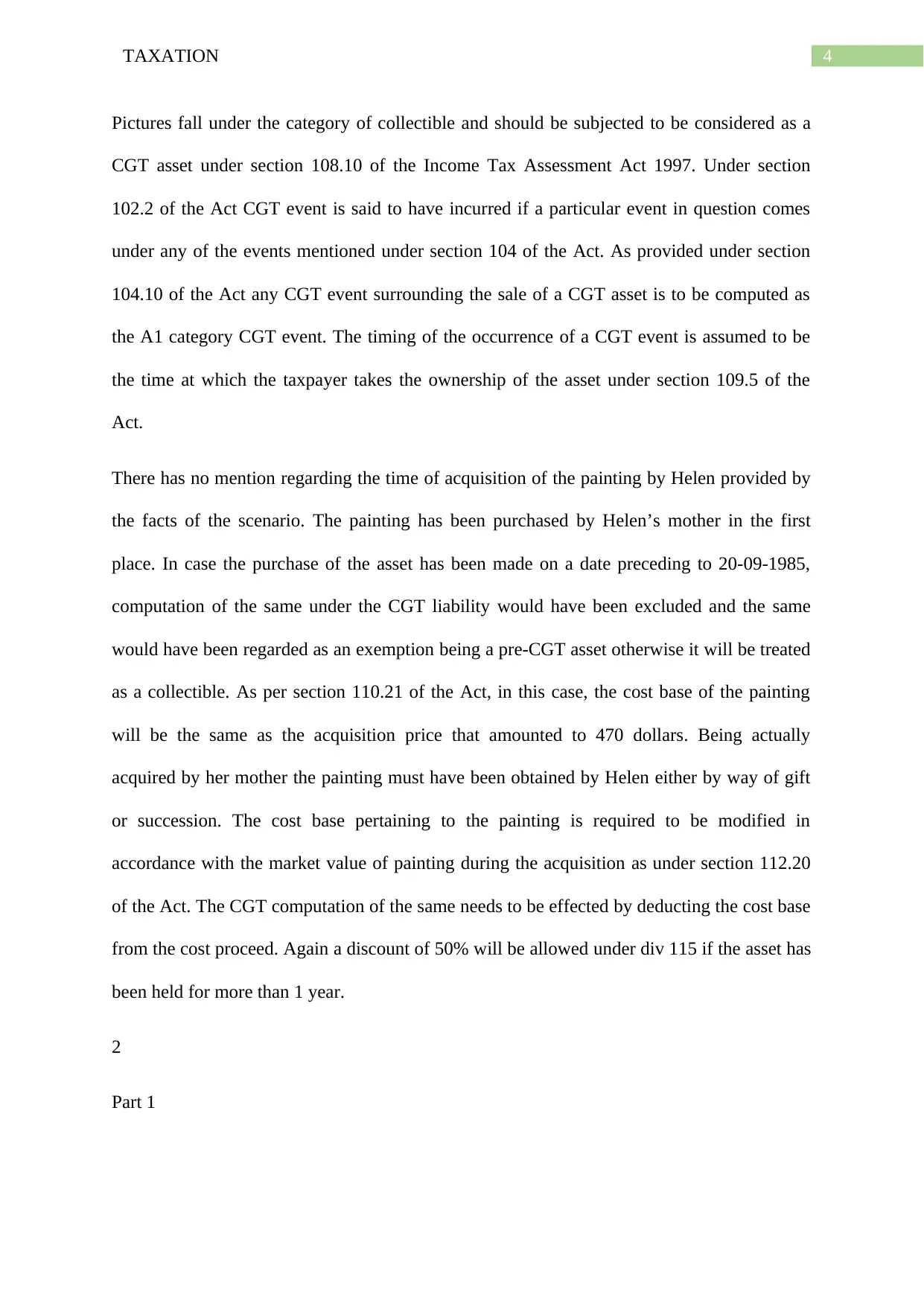
4TAXATION
Pictures fall under the category of collectible and should be subjected to be considered as a
CGT asset under section 108.10 of the Income Tax Assessment Act 1997. Under section
102.2 of the Act CGT event is said to have incurred if a particular event in question comes
under any of the events mentioned under section 104 of the Act. As provided under section
104.10 of the Act any CGT event surrounding the sale of a CGT asset is to be computed as
the A1 category CGT event. The timing of the occurrence of a CGT event is assumed to be
the time at which the taxpayer takes the ownership of the asset under section 109.5 of the
Act.
There has no mention regarding the time of acquisition of the painting by Helen provided by
the facts of the scenario. The painting has been purchased by Helen’s mother in the first
place. In case the purchase of the asset has been made on a date preceding to 20-09-1985,
computation of the same under the CGT liability would have been excluded and the same
would have been regarded as an exemption being a pre-CGT asset otherwise it will be treated
as a collectible. As per section 110.21 of the Act, in this case, the cost base of the painting
will be the same as the acquisition price that amounted to 470 dollars. Being actually
acquired by her mother the painting must have been obtained by Helen either by way of gift
or succession. The cost base pertaining to the painting is required to be modified in
accordance with the market value of painting during the acquisition as under section 112.20
of the Act. The CGT computation of the same needs to be effected by deducting the cost base
from the cost proceed. Again a discount of 50% will be allowed under div 115 if the asset has
been held for more than 1 year.
2
Part 1
Pictures fall under the category of collectible and should be subjected to be considered as a
CGT asset under section 108.10 of the Income Tax Assessment Act 1997. Under section
102.2 of the Act CGT event is said to have incurred if a particular event in question comes
under any of the events mentioned under section 104 of the Act. As provided under section
104.10 of the Act any CGT event surrounding the sale of a CGT asset is to be computed as
the A1 category CGT event. The timing of the occurrence of a CGT event is assumed to be
the time at which the taxpayer takes the ownership of the asset under section 109.5 of the
Act.
There has no mention regarding the time of acquisition of the painting by Helen provided by
the facts of the scenario. The painting has been purchased by Helen’s mother in the first
place. In case the purchase of the asset has been made on a date preceding to 20-09-1985,
computation of the same under the CGT liability would have been excluded and the same
would have been regarded as an exemption being a pre-CGT asset otherwise it will be treated
as a collectible. As per section 110.21 of the Act, in this case, the cost base of the painting
will be the same as the acquisition price that amounted to 470 dollars. Being actually
acquired by her mother the painting must have been obtained by Helen either by way of gift
or succession. The cost base pertaining to the painting is required to be modified in
accordance with the market value of painting during the acquisition as under section 112.20
of the Act. The CGT computation of the same needs to be effected by deducting the cost base
from the cost proceed. Again a discount of 50% will be allowed under div 115 if the asset has
been held for more than 1 year.
2
Part 1
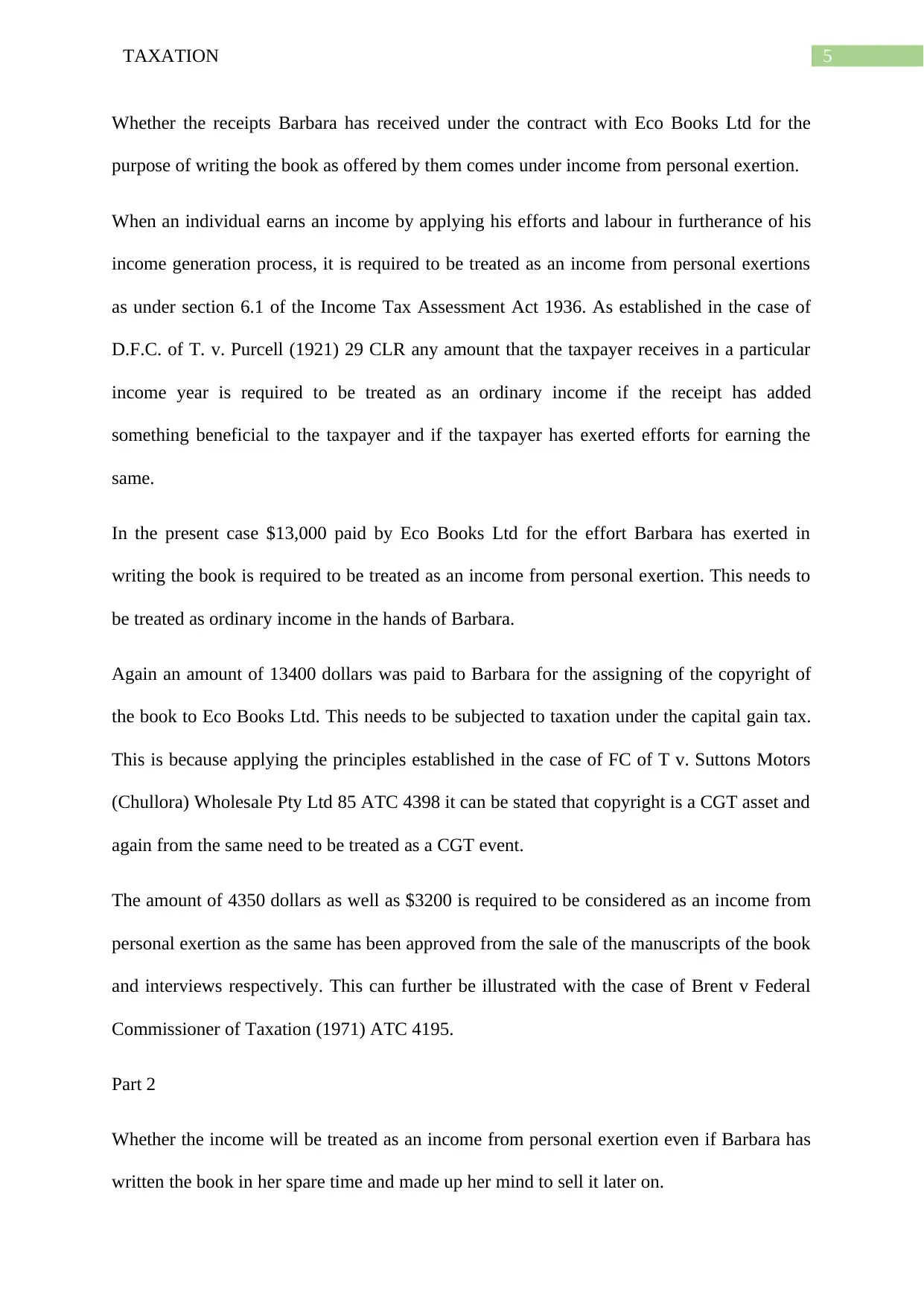
5TAXATION
Whether the receipts Barbara has received under the contract with Eco Books Ltd for the
purpose of writing the book as offered by them comes under income from personal exertion.
When an individual earns an income by applying his efforts and labour in furtherance of his
income generation process, it is required to be treated as an income from personal exertions
as under section 6.1 of the Income Tax Assessment Act 1936. As established in the case of
D.F.C. of T. v. Purcell (1921) 29 CLR any amount that the taxpayer receives in a particular
income year is required to be treated as an ordinary income if the receipt has added
something beneficial to the taxpayer and if the taxpayer has exerted efforts for earning the
same.
In the present case $13,000 paid by Eco Books Ltd for the effort Barbara has exerted in
writing the book is required to be treated as an income from personal exertion. This needs to
be treated as ordinary income in the hands of Barbara.
Again an amount of 13400 dollars was paid to Barbara for the assigning of the copyright of
the book to Eco Books Ltd. This needs to be subjected to taxation under the capital gain tax.
This is because applying the principles established in the case of FC of T v. Suttons Motors
(Chullora) Wholesale Pty Ltd 85 ATC 4398 it can be stated that copyright is a CGT asset and
again from the same need to be treated as a CGT event.
The amount of 4350 dollars as well as $3200 is required to be considered as an income from
personal exertion as the same has been approved from the sale of the manuscripts of the book
and interviews respectively. This can further be illustrated with the case of Brent v Federal
Commissioner of Taxation (1971) ATC 4195.
Part 2
Whether the income will be treated as an income from personal exertion even if Barbara has
written the book in her spare time and made up her mind to sell it later on.
Whether the receipts Barbara has received under the contract with Eco Books Ltd for the
purpose of writing the book as offered by them comes under income from personal exertion.
When an individual earns an income by applying his efforts and labour in furtherance of his
income generation process, it is required to be treated as an income from personal exertions
as under section 6.1 of the Income Tax Assessment Act 1936. As established in the case of
D.F.C. of T. v. Purcell (1921) 29 CLR any amount that the taxpayer receives in a particular
income year is required to be treated as an ordinary income if the receipt has added
something beneficial to the taxpayer and if the taxpayer has exerted efforts for earning the
same.
In the present case $13,000 paid by Eco Books Ltd for the effort Barbara has exerted in
writing the book is required to be treated as an income from personal exertion. This needs to
be treated as ordinary income in the hands of Barbara.
Again an amount of 13400 dollars was paid to Barbara for the assigning of the copyright of
the book to Eco Books Ltd. This needs to be subjected to taxation under the capital gain tax.
This is because applying the principles established in the case of FC of T v. Suttons Motors
(Chullora) Wholesale Pty Ltd 85 ATC 4398 it can be stated that copyright is a CGT asset and
again from the same need to be treated as a CGT event.
The amount of 4350 dollars as well as $3200 is required to be considered as an income from
personal exertion as the same has been approved from the sale of the manuscripts of the book
and interviews respectively. This can further be illustrated with the case of Brent v Federal
Commissioner of Taxation (1971) ATC 4195.
Part 2
Whether the income will be treated as an income from personal exertion even if Barbara has
written the book in her spare time and made up her mind to sell it later on.
⊘ This is a preview!⊘
Do you want full access?
Subscribe today to unlock all pages.

Trusted by 1+ million students worldwide
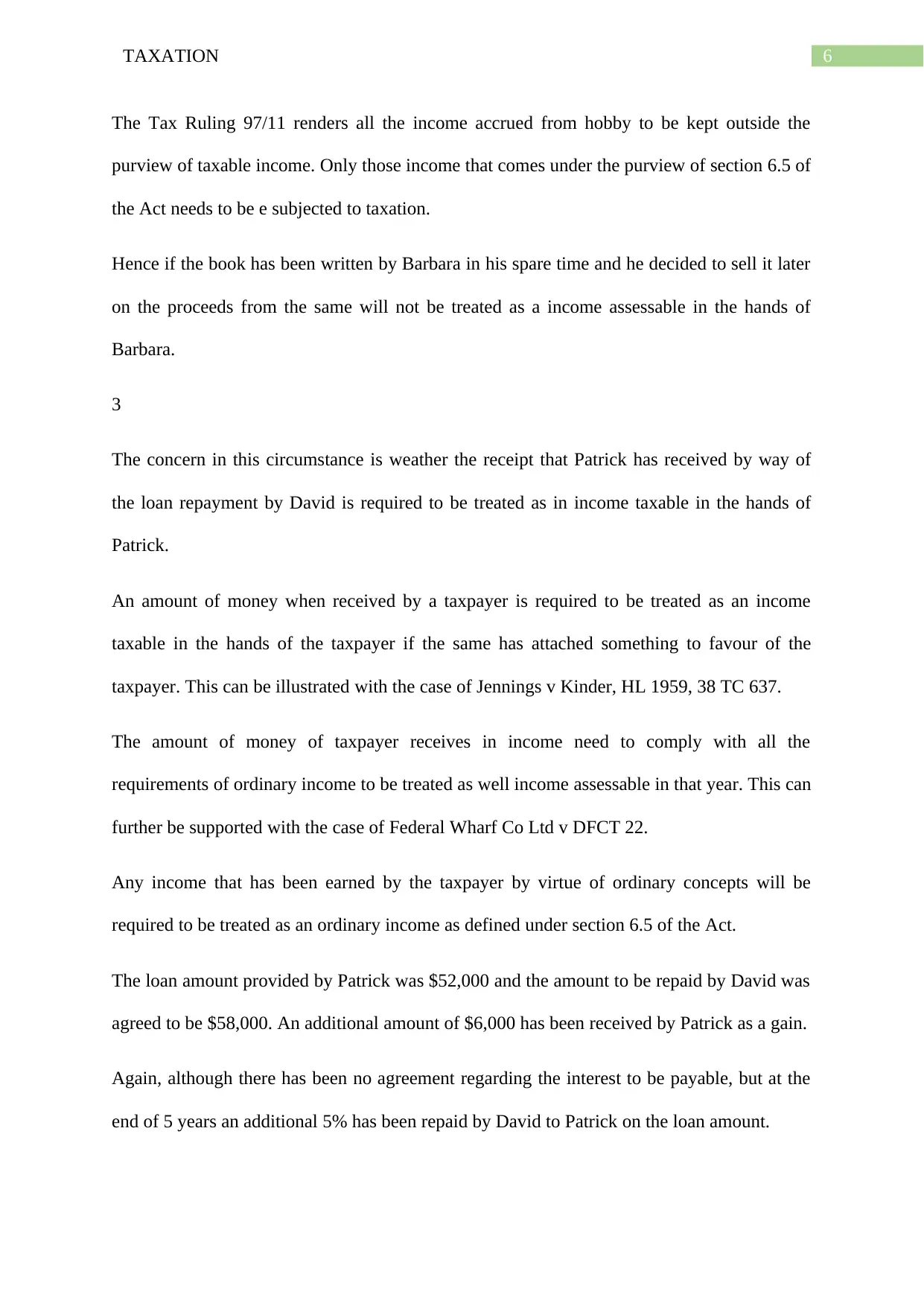
6TAXATION
The Tax Ruling 97/11 renders all the income accrued from hobby to be kept outside the
purview of taxable income. Only those income that comes under the purview of section 6.5 of
the Act needs to be e subjected to taxation.
Hence if the book has been written by Barbara in his spare time and he decided to sell it later
on the proceeds from the same will not be treated as a income assessable in the hands of
Barbara.
3
The concern in this circumstance is weather the receipt that Patrick has received by way of
the loan repayment by David is required to be treated as in income taxable in the hands of
Patrick.
An amount of money when received by a taxpayer is required to be treated as an income
taxable in the hands of the taxpayer if the same has attached something to favour of the
taxpayer. This can be illustrated with the case of Jennings v Kinder, HL 1959, 38 TC 637.
The amount of money of taxpayer receives in income need to comply with all the
requirements of ordinary income to be treated as well income assessable in that year. This can
further be supported with the case of Federal Wharf Co Ltd v DFCT 22.
Any income that has been earned by the taxpayer by virtue of ordinary concepts will be
required to be treated as an ordinary income as defined under section 6.5 of the Act.
The loan amount provided by Patrick was $52,000 and the amount to be repaid by David was
agreed to be $58,000. An additional amount of $6,000 has been received by Patrick as a gain.
Again, although there has been no agreement regarding the interest to be payable, but at the
end of 5 years an additional 5% has been repaid by David to Patrick on the loan amount.
The Tax Ruling 97/11 renders all the income accrued from hobby to be kept outside the
purview of taxable income. Only those income that comes under the purview of section 6.5 of
the Act needs to be e subjected to taxation.
Hence if the book has been written by Barbara in his spare time and he decided to sell it later
on the proceeds from the same will not be treated as a income assessable in the hands of
Barbara.
3
The concern in this circumstance is weather the receipt that Patrick has received by way of
the loan repayment by David is required to be treated as in income taxable in the hands of
Patrick.
An amount of money when received by a taxpayer is required to be treated as an income
taxable in the hands of the taxpayer if the same has attached something to favour of the
taxpayer. This can be illustrated with the case of Jennings v Kinder, HL 1959, 38 TC 637.
The amount of money of taxpayer receives in income need to comply with all the
requirements of ordinary income to be treated as well income assessable in that year. This can
further be supported with the case of Federal Wharf Co Ltd v DFCT 22.
Any income that has been earned by the taxpayer by virtue of ordinary concepts will be
required to be treated as an ordinary income as defined under section 6.5 of the Act.
The loan amount provided by Patrick was $52,000 and the amount to be repaid by David was
agreed to be $58,000. An additional amount of $6,000 has been received by Patrick as a gain.
Again, although there has been no agreement regarding the interest to be payable, but at the
end of 5 years an additional 5% has been repaid by David to Patrick on the loan amount.
Paraphrase This Document
Need a fresh take? Get an instant paraphrase of this document with our AI Paraphraser
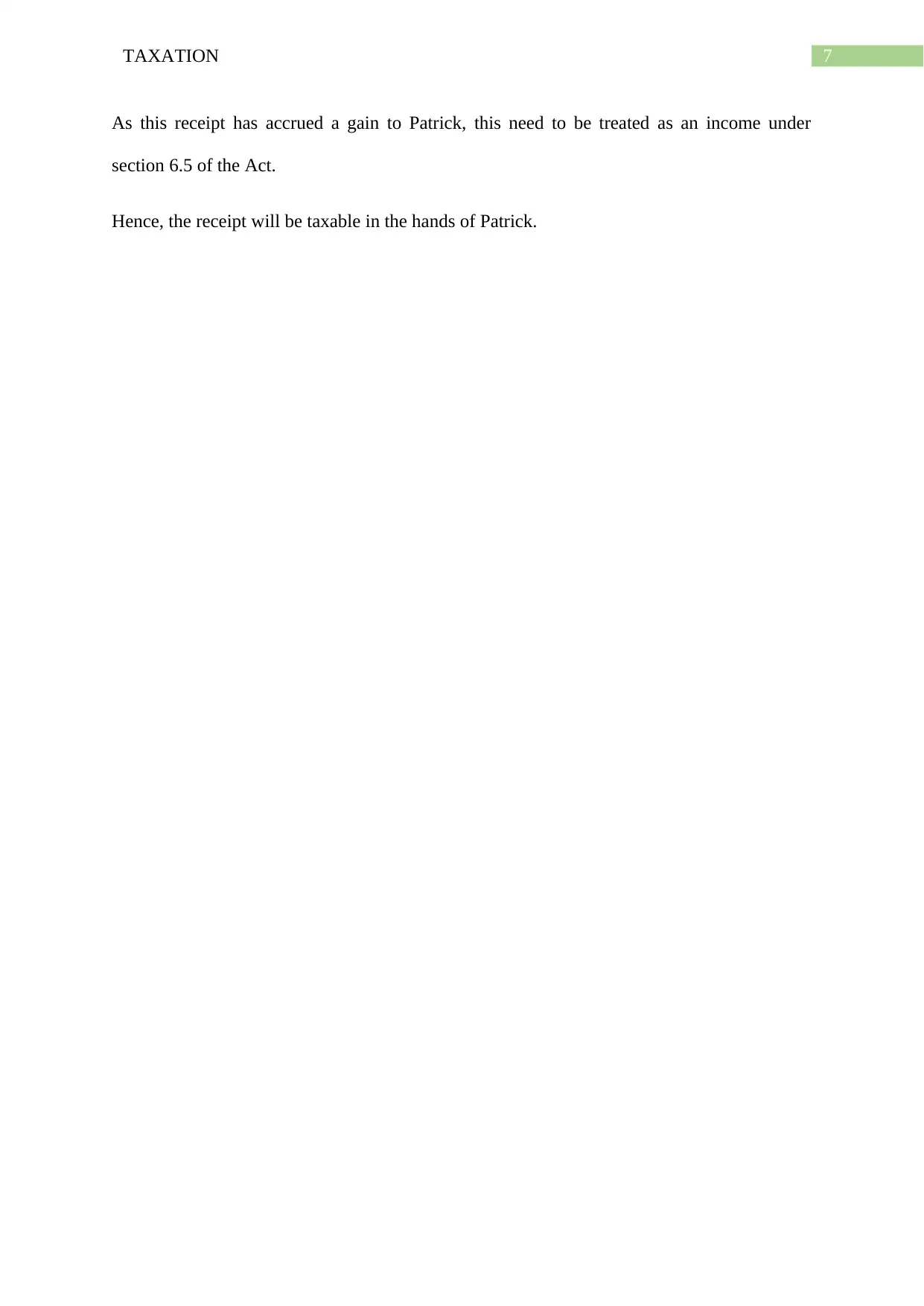
7TAXATION
As this receipt has accrued a gain to Patrick, this need to be treated as an income under
section 6.5 of the Act.
Hence, the receipt will be taxable in the hands of Patrick.
As this receipt has accrued a gain to Patrick, this need to be treated as an income under
section 6.5 of the Act.
Hence, the receipt will be taxable in the hands of Patrick.
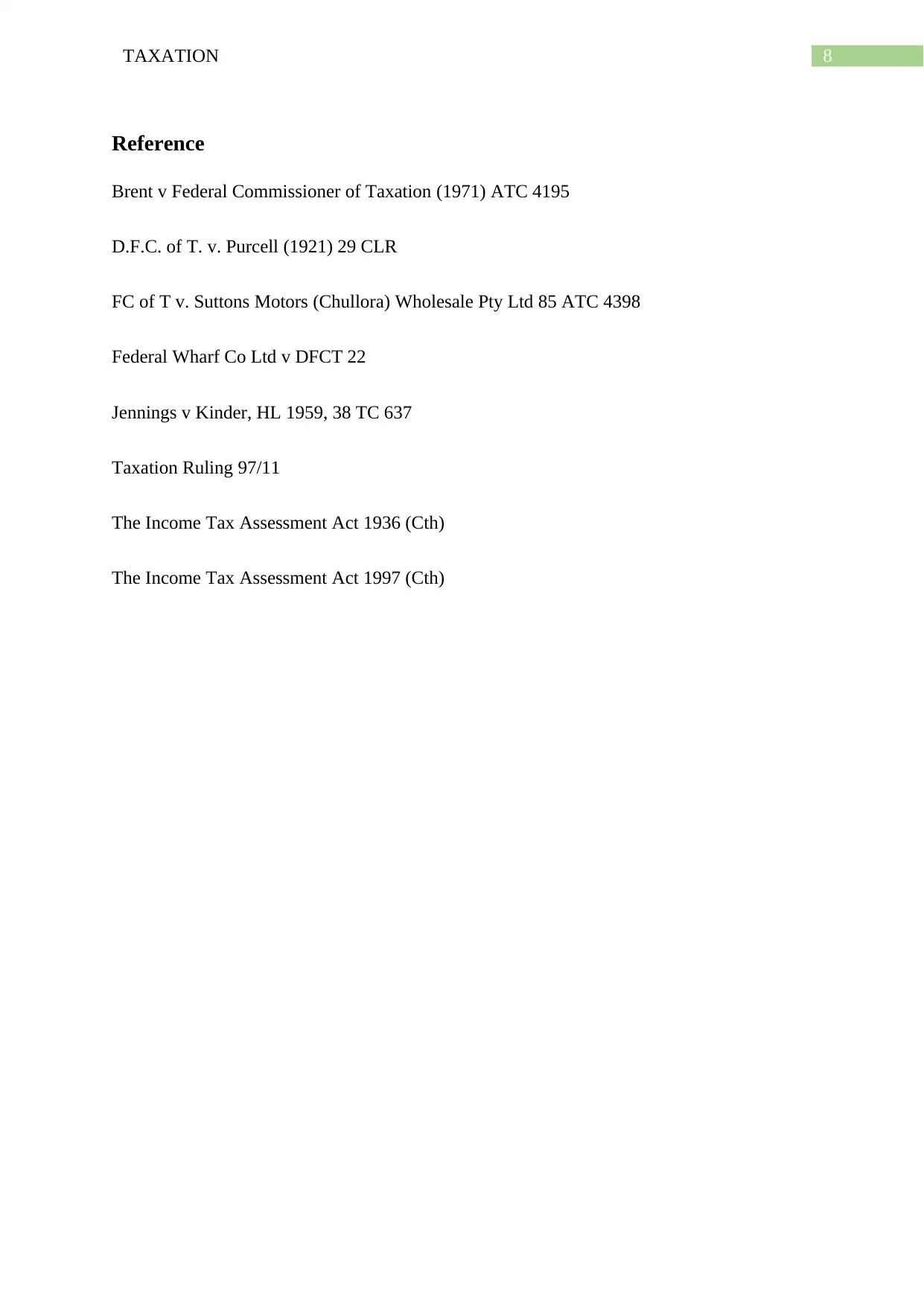
8TAXATION
Reference
Brent v Federal Commissioner of Taxation (1971) ATC 4195
D.F.C. of T. v. Purcell (1921) 29 CLR
FC of T v. Suttons Motors (Chullora) Wholesale Pty Ltd 85 ATC 4398
Federal Wharf Co Ltd v DFCT 22
Jennings v Kinder, HL 1959, 38 TC 637
Taxation Ruling 97/11
The Income Tax Assessment Act 1936 (Cth)
The Income Tax Assessment Act 1997 (Cth)
Reference
Brent v Federal Commissioner of Taxation (1971) ATC 4195
D.F.C. of T. v. Purcell (1921) 29 CLR
FC of T v. Suttons Motors (Chullora) Wholesale Pty Ltd 85 ATC 4398
Federal Wharf Co Ltd v DFCT 22
Jennings v Kinder, HL 1959, 38 TC 637
Taxation Ruling 97/11
The Income Tax Assessment Act 1936 (Cth)
The Income Tax Assessment Act 1997 (Cth)
⊘ This is a preview!⊘
Do you want full access?
Subscribe today to unlock all pages.

Trusted by 1+ million students worldwide
1 out of 9
Related Documents
Your All-in-One AI-Powered Toolkit for Academic Success.
+13062052269
info@desklib.com
Available 24*7 on WhatsApp / Email
![[object Object]](/_next/static/media/star-bottom.7253800d.svg)
Unlock your academic potential
Copyright © 2020–2025 A2Z Services. All Rights Reserved. Developed and managed by ZUCOL.





